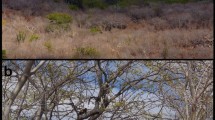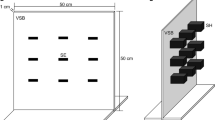Abstract
In arboreal habitats gaps between branches and branch structure profoundly affect the ability of animals to move; hence, an ability to perceive such attributes could facilitate choosing routes that enhance the speed and ease of locomotion. Although many snakes are arboreal, no previous study has determined whether they can perceive structural variation of branches that is mechanically relevant to their locomotion. We tested whether the gap distance, location, and attributes of two destination perches on the far side of a crossable gap affected the route travelled by North American rat snakes (Pantherophis), which are proficient climbers. Snakes usually chose routes with shorter gaps. Within a horizontal plane, the snakes usually went straight rather than crossing an equal distance gap with a 90° turn, which was consistent with our finding that crossing a straight gap was easier. However, decreasing the distance of the gap with a 90° turn eliminated the preference for going straight. Additional factors, such as the width of the landing surface and the complexity of branching of the destination perches, resulted in non-random route choice. Thus, many of the observed biases in route choice suggested abilities to perceive structural variation and select routes that are mechanically beneficial.

Similar content being viewed by others
References
Astley HC, Jayne BC (2007) Effects of perch diameter and incline on the kinematics, performance and modes of arboreal locomotion of corn snakes (Elaphe guttata). J Exp Biol 210:3862–3872
Astley HC, Jayne BC (2009) Arboreal habitat structure affects the performance and modes of locomotion of corn snakes (Elaphe guttata). J Exp Zool Part A 311A:207–216
Barnum SA, Manville CJ, Tester JR, Carmen WJ (1992) Path selection by Peromyscus leucopus in the presence and absence of vegetative cover. J Mammal 73:797–801
Brattstrom BH (1965) Body temperatures of reptiles. Am Midl Nat 73:376–422
Caprette CL (2005) Conquering the cold shudder: the origin and evolution of snake eyes. Dissertation, The Ohio State University
Carello C, Wagman JB (2009) Mutuality in the perception of affordances and the control of movement. In: Sternad D (ed) Progress in motor control. Springer, New York, pp 273–292
Collett TS, Harkness L (1982) Depth vision in animals. In: Goodale MA, Ingle DJ, Mansfield RJW (eds) Analysis of visual behavior. MIT Press, Cambridge, pp 111–176
Conant R, Collins JT (1991) A field guide to reptiles and amphibians of eastern and central North America. Houghton Mifflin Company, Boston
Ewert JP (1982) Neuronal basis of configurational prey selection in the common toad. In: Goodale MA, Ingle DJ, Mansfield RJW (eds) Analysis of visual behavior. MIT Press, Cambridge, pp 7–45
Fajen BR (2009) Introduction to section on perception and action-themes in perception and action. In: Sternad D (ed) Progress in motor control. Springer, New York, pp 263–272
Fitts PM (1954) The information capacity of the human motor system in controlling the amplitude of movement. J Exp Psychol Gen 47:381–391
Gibson JJ (1986) The ecological approach to visual perception. Lawrence Earlbaum Associates Inc., Hillsdale
Henderson RW, Lillywhite HB (1993) Behavioral and functional ecology of arboreal snakes. In: Collins JT, Seigel RA (eds) Snakes—ecology and behavior. McGraw-Hill Inc., New York, pp 1–48
Jayne BC, Riley MA (2007) Scaling of the axial morphology and gap-bridging ability of the brown tree snake, Boiga irregularis. J Exp Biol 210:1148–1160
Kording K (2007) Decision theory: what “should” the nervous system do? Science 318:606–610
Lock A, Collett TS (1979) A toad’s devious approach to its prey: a study of some complex uses of depth vision. J Comp Physiol A 131:179–189
Losos JB (1990) Ecomorphology, performance capability, and scaling of West Indian Anolis lizards: an evolutionary analysis. Ecol Monogr 60:369–388
Losos JB, Irschick DJ (1996) The effect of perch diameter on escape behaviour of Anolis lizards: laboratory predictions and field tests. Anim Behav 51:593–602
Losos JB, Sinervo B (1989) The effects of morphology and perch diameter on sprint performance of Anolis lizards. J Exp Biol 145:23–30
Mattingly WB, Jayne BC (2004) Resource use in arboreal habitats: structure affects locomotion of four ecomorphs of Anolis lizards. Ecology 85:1111–1124
Mattingly WB, Jayne BC (2005) The choice of arboreal escape paths and its consequences for the locomotor behaviour of four species of Anolis lizards. Anim Behav 70:1239–1250
McVea DA, Pearson KG (2009) Object avoidance during locomotion. In: Sternad D (ed) Progress in motor control. Springer, New York, pp 293–315
Moran MD (2003) Arguments for rejecting the sequential Bonferroni ecological studies. Oikos 100:403–405
Mullin SJ, Cooper RJ (2002) Barking up the wrong tree: climbing performance of rat snakes and its implications for depredation of avian nests. Can J Zool 80:591–595
Murata A (1999) Extending effective target width in Fitts’ law to a two-dimensional pointing task. Int J Hum Comput Int 11:137–152
Ott M (2006) Visual accommodation in vertebrates: mechanisms, physiological response and stimuli. J Comp Physiol A 192:97–111
Pizzatto L, Almeida-Santos SM, Shine R (2007) Life-history adaptations to arboreality in snakes. Ecology 88:359–366
Pyron RA, Burbrink FT (2009) Neogene diversification and taxonomic stability in the snake tribe Lampropeltini (Serpentes: Colubridae). Mol Phylogenet Evol 52:524–529
Regolin L, Vallortigara G, Zanforlin M (1994) Perceptual and motivational aspects of detour behavior in young chicks. Anim Behav 47:123–131
Rice WR (1989) Analyzing tables of statistical tests. Evolution 43:223–225
Schoener TW (1968) The Anolis lizards of Bimini: resource partitioning in a complex fauna. Ecology 49:704–726
Shine R, Sun LX, Kearney M, FitzGerald M (2002) Thermal correlates of foraging-site selection by Chinese pit-vipers (Gloydius shedaoensis, Viperidae). J Therm Biol 27:405–412
Sivak JG (1977) The role of the spectacle in the visual optics of the snake eye. Vision Res 17:293–298
Strasser E, Fleagle J, Rosenberger A, McHenry H (1998) Primate locomotion: recent advances. Plenum Press, New York
Tarsitano MS, Andrew R (1999) Scanning and route selection in the jumping spider Portia labiata. Anim Behav 58:255–265
Walls GL (1942) The vertebrate eye and its adaptive radiation. Hafner, New York
Wright AH, Wright AA (1957) Handbook of Snakes. Comstock Publishing Associates, Ithaca
Acknowledgments
E. Buschbeck, J. Layne, M. Riley and G. Byrnes provided helpful comments, suggestions, and direction. B. Murphy, Z. Jones, M. Herrmann, J. Olberding and A. Sturbaum provided assistance with experiments. This work was funded by a grant from the Wiemen-Wendell-Benedict Fund of the University of Cincinnati, Department of Biological Sciences to RHM and by National Science Foundation grant IOS 0843197 to BCJ. Care and treatment of the snakes were approved by the Institutional Animal Care Use Committee (protocol number 07-01-08-01) of the University of Cincinnati, and the principles of laboratory animal care (NIH publication No. 85-23, revised 1985) were followed.
Author information
Authors and Affiliations
Corresponding author
Rights and permissions
About this article
Cite this article
Mansfield, R.H., Jayne, B.C. Arboreal habitat structure affects route choice by rat snakes. J Comp Physiol A 197, 119–129 (2011). https://doi.org/10.1007/s00359-010-0593-6
Received:
Revised:
Accepted:
Published:
Issue Date:
DOI: https://doi.org/10.1007/s00359-010-0593-6




